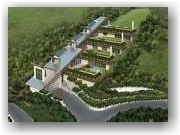 In various times, places, and cultures, the “green” roof was the norm. People lived in earthen homes that were sometimes dug out of hillsides or creek banks, and the native grasses and wildflowers grew naturally on top. Other homes had sod or thatched grass roofs. Modern people are discovering the merits of this kind of roofing. If you are planning to install a green roof, here are some things to consider and keep in mind.
In various times, places, and cultures, the “green” roof was the norm. People lived in earthen homes that were sometimes dug out of hillsides or creek banks, and the native grasses and wildflowers grew naturally on top. Other homes had sod or thatched grass roofs. Modern people are discovering the merits of this kind of roofing. If you are planning to install a green roof, here are some things to consider and keep in mind.
1. Types of Green Roofs
Before you begin, you need to determine what kind of green roof you want. Here are some of the various types.
* Extensive – Despite the name, extensive green roofs require less maintenance than the other two types, we know it’s really counterintuitive, but that’s the way it is. Extensive roofs are nearly self-sufficient, and require maybe an annual weeding or fertilizing but that’s about it. Another plus is that you’ll find extensive green roofs are not as heavy as other green roofs, because they require less soil. If an extensive green roof is going to be covered with moss, a thin layer of growing medium such as rockwool is all that is necessary, pretty cool, huh?
* Semi-Intensive – These green roofs require more intensive maintenance – hence the name (sure that makes sense, right?). Some things to remember about semi-intensive roofs is that they require regular watering, sometimes in the form of irrigation, and they also require regular weeding and fertilizing. The upside is that semi-intensive roofs do offer more variety than extensive green roofs. Shrubs, perennials, and herbs can be grown on a semi-intensive roof. If you have easy roof access growing herbs on your roof can be a really great use of space and make for a fragrent and useful roof as well.
* Intensive – This high-maintenance green roofing option offers the most variety of design and flora. With this roof people often include garden paths, rock formations, fountains, and other elaborate additions as part of an intensive green roof. Large, flat-topped buildings can even have playgrounds and park-like settings as part of their green roof.
Don’t let the high-maintenance scare you. High-maintenance is not necessarily bad. If you are the kind of person who likes to spend time in a garden – and maybe you don’t have the land to have a regular garden – then an intensive green roof could be a good investment for you.
2. A Weighty Issue
Soil and sod are heavy. Before you get too far into your green roofing project, take the time an make the investment to have a professional determine the strength and weight-bearing capability of your walls. This is especially important if you are installing the green roof over your existing roof.
3. Choose Your Plants
Think about what kinds of plants you want on your green roof. If you want to provide a sanctuary for wildlife such as bees, hummingbirds and butterflies, then plant flowering species. If you are concerned about the surrounding eco-systems and habitats, consider native plantings for your green roof.